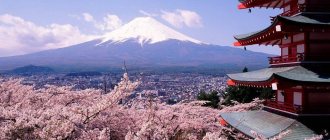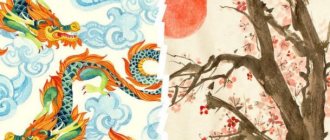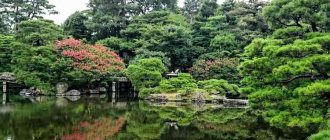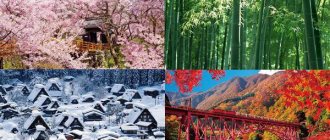There must be a lot of symbols
It seems that the Japanese think so. They do not have a one and only revered animal. Japan is a wonderful country, everything is special there. It is not surprising that there are several totem animals. Here they are:
There are also sacred animals associated with the star chart, although two of them are mythical creatures.
I’ll tell you about every animal that is significant to the Japanese.
Tanuki
It is believed that this animal brings prosperity and happiness. Although in Japanese folklore a tanuki is a cunning and rogue who can change his disguise. He is a werewolf and a representative of the dark side, he is still loved and revered. He is the hero of many fairy tales, and his images in the form of figurines stand at the entrances of many houses. The Japanese also like to depict it on the signs of drinking establishments - there is an opinion that the animal is a big lover of sake.
Moreover, among the Japanese this symbol of well-being looks like a good-natured fat man with a noticeable paunch. Moreover, in addition to well-being, the tanuki protects fertility, so on the figurines this animal is “equipped with housekeeping” - that’s how they are, these Japanese J. And in the land of sakura they believe that if you wrap gold in the skin of a tanuki and knock on the package, then the precious metal will be twice as large.
Pheasant-kiji
The Kiji pheasant is the hero of many Japanese fairy tales.
This bird, the symbol of Japan, runs faster than all its kind. Kiji pheasants spend almost all of their time on the ground. They can take off, but rarely and only in case of great danger. Pheasants have bright plumage and a long tail. These birds are the heroes of many fairy tales and legends of the Japanese people.
We recommend reading: A simple recipe for the winter
Even Japanese banknotes have an image of a kiji pheasant. The female pheasant loves her pets very much. Because of this strong maternal love, this bird was unofficially called the bird symbolizing a strong family.
Deer
The sacred deer represents fertility. However, this animal is not a symbol for all Japanese. Sika deer are especially revered in the city of Nara. In ancient times, it was the capital of Japan. The city is very picturesque, but its main feature is the crowds of well-fed lazy deer reclining on the streets. There are more than a thousand of them here. Tourists buy special crackers to feed their horned friends. If deer are sleeping on the roadway, then it is prohibited to drive them away; you can only go around or drive around. Because all these animals are descendants of that magical deer on which the first Japanese Emperor descended from the sky. And the messengers of the gods cannot be offended, but they can be fed deliciously. Japanese deer live well here.
Tancho:
The stork became a symbol because of the round red spot located on its head. Tanchozuru (タンチョウヅル・丹頂鶴 - "tan" means the red part, "cho" means the head, and "tsuru" means the stork). In Japan, the red circle is always associated with the sun and life, because even on the national flag there is this image. There are not very many tanchos on the islands, so it is not so easy to meet them. It is not surprising that the people of Japan decided that a stork with a red circle on its head brings good luck. Japan, a country that honors and believes in symbols. There is a superstition that if you make 1000 Tancho paper storks, a lucky event will happen!
Japanese stork
Another symbol of the Japanese is the Japanese white stork. This bird lives not only in Japan, but there is no such reverence and admiration for storks anywhere else. This large and proud bird from the order of ankles has a long beak, neck and legs.
The bird's feet are equipped with special membranes that help it swim well. It is impossible to hear a single sound from the stork due to the reduction of its vocal cords. With the help of their huge wings, birds can easily cover long distances.
In the sky, birds can be easily recognized by their outstretched necks in flight. Storks are distinguished by their enviable constancy in everything, so in Japan they are considered a symbol of home comfort and well-being.
Four cardinal directions - four symbolic animals
China has had a strong influence on the people of Japan in many areas of life. Mythology is also no exception. There is a legend about four sacred animals associated with the signs of the zodiac. Allegedly, these magical animals protect the country from each side of the world.
Let me explain. Some zodiac symbols previously also meant cardinal directions.
Both the Chinese and Japanese consider these animals to be protectors; they used to even make sacrifices to them. Some cities were built with an eye on these symbolic creatures. Tokyo, for example, is positioned with this in mind. The turtle is the mountain, the dragon is the river, the tiger is the road, the Phoenix is the sea. True, not all areas in Tokyo strictly correspond to the cardinal directions. Mount Fuji, symbolizing the turtle, is not located clearly in the north, but for the Japanese this is a minor deviation from the legend.
By the way, the turtle in Japan is considered an extraordinary animal, symbolizing wisdom and longevity. Its shell is sometimes used for fortune telling.
Mythical animals
Their images are actively used in the art of tattooing.
A beast that drives away evil. Outwardly it looks like a bull, with the head of an elephant, rat eyes, tiger paws and a cow tail. Baku is all covered with fur, like a lion. Creepy creature. But despite its repulsive appearance, the animal helps people by devouring their nightmares and driving away evil spirits.
This is carp. Considered a masculine symbol. When a boy was born, parents hung pictures of fish outside the threshold. Also, at the beginning of May there is a holiday called “Boys’ Day”, when for several days, at home where there are boys, parents hang out a kind of “kite” with the image of a carp. This symbol has the meaning of victory, overcoming obstacles, inspiration.
According to legend , every Koi fish must rise to the Dragon Gate, along the Yellow River, where it itself will turn into a dragon. Apparently there is a connection in this, because. Many ancient paintings, and modern objects of art, clothing, depict a carp climbing upstream - it is believed that such a symbol will bring good luck and prosperity.
Another mythological animal image. The animal is strange, has the body of a deer, the head of a wolf, the legs of a horse, and one horn. The Kirin is covered in scales like a dragon, shoots fire from its mouth, howls horribly, eats plants and brings prosperity. The beast protects the house from negativity and protects a person from evil forces.
Other characters
Other significant totem animals for the Japanese are the owl, dog, goldfish, snake, and roe deer. Their images bring goodness and endow a person with positive qualities.
Japan is magical and unique, just like its symbols. That’s all I have for today about this mysterious country. Wait for new publications! Join and subscribe to my Telegram channel, I have something to tell you! Discuss with friends on social networks. Have a good day!
Source
Raccoon dog symbol of Japan
The Japanese dragon differs from the Chinese only in that it has three toes instead of five on its paws.
In Japanese mythology, kame is a symbol of power and immortality; kame supports the World Mountain, which is the refuge of the immortals. It can often be seen in traditional Japanese painting, including the works of Hokusai.
One of the most popular Japanese folk tales, Urashima Taro, is associated with kame. A man named Urashima Taro once rescued a turtle, who then took him to an underwater palace. There the turtle turned into Princess Otohime. The princess danced for the guest and gave him a box, which she forbade him to open. After spending several days in the castle, Urashima Taro returned home and discovered that 100 years had already passed on earth! Despite Princess Otohime's prohibition, Taro opened the box and instantly turned into a gray-haired old man. This folk tale has been known since the 8th century.
The Neko
Neko cat and its variant Maneki Neko (beckoning cat) are a Japanese symbol of happiness and prosperity.
The first domestic cats came to Japan in the 6th century thanks to a Buddhist monk who was tasked with bringing ancient manuscripts. Trying to bring the sacred scriptures safe and sound, the monk took a domestic cat on the sea voyage from China to Japan to protect the manuscripts from rats. The cat fulfilled its duty and remained in Japan. Due to the small number (and therefore high cost) of cats, only wealthy people could afford to keep them at home. Collars were made for the cats and a bell was hung so that they would not get lost. Cats were also kept at Buddhist temples, they were carefully protected and kept on a special leash. Cat figurines can be with open or closed eyes. Closed eyes symbolize receiving desired benefits in the near future, while open eyes symbolize the fulfillment of desires in the future. In addition, Nekos have different additions: a red or multi-colored collar, and a bell or coin on the collar. Carp represents masculinity, victory, striving for goals and achieving results. This fish is endowed with such symbolism due to the fact that it is very hardy and tenacious. Koi carp swim against the current, swim great distances and overcome rapids on the way to their spawning grounds, thereby personifying will, perseverance and the ability to cope with life's difficulties.
Carp frolic in crystal clear ponds. The simple ones are rightly distinguished from the koi by the thick spray of the sun...
Kokoro
Frog Kaeru
It denotes invulnerability in life’s journeys, for the verb “kaeru” means “to return safely.”
Therefore, the Japanese often associate the frog with travel. A miniature image of a frog is often used as a talisman, helping to endure all the hardships of travel and return home without loss.
Kaeru is also a symbol of beauty and purity. Frogs live in clean water bodies and do not live anywhere.
Therefore, he is usually depicted with a bottle of sake in one hand and an unpaid bill in the other. This is a symbol of creative search, because this animal is distinguished by mischief and unpredictability.
In Kyoto there is an entire temple complex dedicated to the raccoon dog - Tanukiyama Fudoin.
This is strength, power, dignity. In Japan, the lion is a mixture of the Chinese lion and the Korean dog.
According to beliefs, the lion is the mythical protector of the Law, the guardian of sacred buildings. It is a symbol of power and success, royal power and strength.
Source
Animals of Japan. Description, names and characteristics of animals in Japan
The fauna of Japan is determined by endemics, that is, individual subspecies of fauna that live only on the island. Very often, animals have small forms compared to mainland representatives. They are called Japanese subspecies; the island has several climatic zones, so the fauna is diverse.
The nearby islands readily welcome migratory birds. There are very few reptiles in Japan, only a few species of lizards and two species of poisonous snakes.
The peculiarity of the animal world of Japan is its wide variety of fauna. Specimens in the wild remained in nature reserves, closed national and marine parks.
In the land of the rising sun there is a special attitude towards animals. Many provinces in Japan have their own sacred animal . For example, in the former capital of Nara it is the sika deer. In marine regions, petrels or three-toed woodpeckers. The green pheasant called “Kiji” is considered to be a national treasure.
Pictured is a raccoon dog
It is typical for Japan to name animals from their place of residence. Numerous islets boast an abundance of subspecies. Northern Kyushu is proud of the white-breasted bear, Japanese macaque, badger, Japanese sable, raccoon dog, moles, mandarin ducks, and pheasants.
*Sika deer is an important and beloved animal by the Japanese. It is he who occupies a special place in fiction and folklore. The body length reaches from 1.6 to 1.8 m, the height at the withers is 90-110 cm.
It has an unusual fiery red color with small white spots. In winter, the color takes on a uniform shade. Inhabits deciduous forests of coastal zones. The horns have four ends, shedding occurs in April, after a month the young shoots are clearly visible. Natural enemies are wolves, leopards, and less commonly foxes.
Dappled deer
*Green pheasant "Kiji" is an animal considered a symbol of Japan . Lives in hilly and bushy areas. Distributed on the islands of Honshu, Shikoku and Kyushu.
The pheasant is an exclusively endemic species, therefore there is a possibility of assigning it a separate species. The bird is painted bright green. The length of the animal ranges from 75-90 cm, where half the length is the tail. Body weight barely reaches 1 kilogram. The female is much smaller than the male, her color looks poor in comparison.
Attractions
Fuji is a visiting card of Japan, a real natural monument. Local residents consider the mountain sacred. Guests of the country are attracted by its beautiful snow cone, and guides and a well-developed tourist infrastructure help them conquer the peak.
Todai-ji Temple is the holiest site in Japan and the largest wooden structure in the world, hosting three million visitors a year. It houses a giant bronze statue of Buddha Vairochana, the Great Buddha of Todai-ji.
The temple area is a deer park where sacred deer roam freely and are fed by tourists. On the territory of the temple complex there are a large number of unique structures: the February Nigatsu-do pavilion, the March Sangatsu-do pavilion and other pagodas and temples.
The Arashiyama Bamboo Grove is a famous symbol of Japan and a favorite place for tourists to visit. The grove was created by the monk Muso Soseki. An incredible place where you want to walk to the sounds of bamboo, despite the clock.
The picturesque Mount Koyasan is home to many temples and Shingon Buddhist schools. Every year it receives many tourists.
Jigokudani Snow Monkey Park on the island of Honshu - tourists come here to see the monkeys basking in the waters of the thermal springs.
Aokigahara Forest, also called the Suicide Forest, is a national park with several hiking trails. The place earned such a terrible name due to the huge number of suicides that occurred on its territory. Why people are drawn specifically here to commit suicide is still unknown.
Raccoon dog
The raccoon dog is a canid mammal native to East Asia. Although it is very similar in appearance to the North American raccoon, this species is not closely related to it, nor is it to the domestic dog. According to zoologists, it is most closely related to none other than the South American and bat-eared foxes.
Raccoon, Japanese raccoon dog, Ussuri fox, Japanese badger, tanuki, mangut and neoguri are other names associated with this mammal. Scientifically, the raccoon dog is called “Nyctereutes procyonoides”, which means “night wanderer”.
Marine life
In the region of the Sea of Japan in winter, due to the northeast wind characteristic of this season, there is heavy snowfall, which is rarely observed in the Pacific Ocean. Summer is colder than in the Pacific coast area, where this season is usually hot and humid, but winter is cold here. All this creates conditions for six hundred species of fish to live in coastal waters: Pacific herring, willow, tuna, cod, flounder and others.
spider crab
In the list of thousands of species of shellfish, in addition to crabs, shrimp and oysters, there are also exotic ones; it’s not for nothing that Japan is famous for its seafood cuisine. The rivers here are home to catfish, carp and lamprey. And eels and salmon, for example, trout, are grown artificially.
Range and habitat of the raccoon dog
The raccoon dog is native to East Asian countries, namely China, Korea, Japan, Vietnam and Northeast Indochina.
From the 20s to the 50s. last century, this species was introduced into the territory of European countries and Western Russia; he was bred on fur farms and released into the wild. Released into their natural habitat, the animals spread throughout most of Eastern Europe and captured northwestern Finland.
Now these animals are abundant throughout Estonia, Finland, Latvia and Lithuania, Bulgaria, Serbia, France, Romania, Slovakia, Czech Republic, Switzerland, Austria, Belarus, Poland, Bosnia and Herzegovina, Moldova, North Macedonia, Romania, Germany, Norway , European part of Russia, Ukraine, Denmark and Sweden.
The habitat of raccoon dogs is characterized by two features:
The raccoon dog prefers open landscapes, especially wet meadows, swamps and riverbanks, but avoids large coniferous forests and other open woodlands with dense canopy. Can settle in small deciduous and mixed forests. It usually needs dense undergrowth to provide shelter and food. In barren areas with sparse undergrowth, the raccoon is almost never found. In mountainous areas, tanuki use river valleys. Animals do not climb high into the mountains, where winters are harsh.
Birds
There are a lot of birds here, about eight hundred species. Synanthropic species (living near human habitation, but not domesticated) include swallows, large-billed crows and carrion crows.
The coast is home to many seabirds, cranes, and storks. The following have adapted to live in mountain forests in large numbers:
- woodpeckers,
- blackbirds,
- tits,
- starlings,
- black grouse,
- hawks,
- eagles,
- owls,
- common and blue magpies,
- kukshi,
- nutcrackers.
Green Pheasant
Among them, Green Pheasant, Amami Woodcock, Ornamented Jay are endemic species. Tropical fauna is characteristic of the southern part of Nippon.
What does a raccoon dog look like?
The body length of an adult is 50-70 cm, weight - from 4 to 9 kg. The body of the animal is elongated, stocky, the legs are short and thin, the tail is 13-18 cm long and covered with thick hair.
Tanuki are characterized by a "face mask", small rounded ears, a pointed muzzle and long hair on the cheeks (whiskers).
The fur is long and dense, with a dense undercoat and coarse guard hairs, especially during the winter months. It protects animals well from low temperatures. Fur color varies from dark brown to silver or gray; in summer the fur is somewhat brighter.
There is a dark stripe on the back that widens at the shoulders, forming a cross shape. The abdomen is yellowish-brown, the chest is dark brown or blackish.
Rare white raccoon dogs are found in Japan and China.
In summer, the fur is thin and fat reserves are small, so the animal looks quite slender.
By autumn, the animal fattens up a layer of subcutaneous fat, and its fur becomes thicker and more luxuriant; at this time he gives the impression of a well-fed animal with short legs.
Raccoon and raccoon dog: what is the difference?
At first glance, a raccoon dog and a raccoon are very similar, but there are still a few key differences between them. They are as follows:
1) a raccoon dog’s fur is thicker and longer than that of a raccoon;
2) raccoons have a white rim on the edge of the inside of their ears, and a black stripe runs from the forehead to the very tip of the nose. Raccoon dogs do not have such a stripe, and the rim on their ears is black;
3) the raccoon has a long tail, on which there are 5-7 black rings, the tanuki has a shorter tail and without rings;
4) a raccoon’s fur on its legs matches the color of the fur on its body, while a tanuki’s fur on its legs is always black;
5) a raccoon has five fingers on its paws - its paws resemble human hands, and a raccoon dog has four fingers, like a dog or a fox.
Raccoon paws
Tanuki lifestyle and behavior
Raccoon dogs are social animals. They live and hunt in pairs or small family groups. However, in most cases, people see them alone.
Tanuki are active mainly at night. Their eyesight is poor, so when searching for food, they rely entirely on their keen sense of smell. They can climb trees, swim and even dive.
Raccoon dogs exhibit behavior that is quite typical for canines. However, they don't bark; instead, they emit a growl followed by a long, sad howl.
Diet
The raccoon dog eats everything it can catch. However, this species is more of an omnivorous gatherer than a skilled predator. The tanuki has short legs, small teeth and a long intestine, and is quite clumsy and slow.
The composition of food varies depending on the area and time of year. For example, in Japan their diet is dominated by fruits, insects and sea animals. In most other areas, the bulk of the diet consists of small rodents - voles, mice and shrews. Frogs, lizards, invertebrates, birds and their eggs are also often consumed by tanuki, especially in early summer. When there are few voles, raccoon dogs focus on catching birds. The animals eat berries and fruits in late summer and autumn; they serve as an important source of food before entering hibernation. In the fall, they also sometimes eat grains such as oats or corn. Carrion is consumed throughout all seasons. It is especially important in winter when other food sources are scarce.
Raccoon dogs prefer to search for food in damp forests with a dense lower layer consisting of ferns.
Tanuki, like raccoons, sometimes “wash” their food.
Hibernation
Raccoon dogs are the only members of the family that hibernate in winter. At this time, they use fat reserves as the main source of energy.
They winter in pairs. Hibernation, depending on the habitat, lasts from November to March, but if the winter is mild, raccoon dogs can be active in the middle of winter. They usually sleep at an air temperature of 35 cm and day length Enemies and threats
The main natural enemies of raccoon dogs are wolves, lynxes, foxes and large birds of prey.
Their main threat is hunting, and they are often persecuted as pests. Many of them die on the roads and as a result of epidemics. Populations may also decline due to habitat loss.
The species is currently classified as "Least Concern" according to the IUCN list and its numbers are stable.
Serau
For a long time, this animal has been on the verge of extinction, so the serow has long been listed in the Red Book and is considered an endangered species. After this animal was declared a natural heritage in 1955, the serow population began to increase significantly.
But with this increase in the number of animals comes a lot of problems that people in different places are trying to solve in different ways. It was allowed to hunt serow until a certain number of them were shot in order not to bring these wolves in sheep's clothing to the brink of extinction again.
This animal is small in size, weighing about 38 kg with a height of up to 90 cm. There are also giants among them, whose weight reaches up to 130 kg. Male serows are usually larger than females. Both have horns, the rings of which determine the age of the animals. The serow's first ring appears at 1.5 years.
These wolves in sheep's clothing prefer to spend most of their lives in splendid isolation. They form a pair only during the rut in order to continue their race. They are active in the morning and evening.
Is it possible to keep a raccoon dog at home?
The raccoon dog is not suitable for life as a pet; caring for it is much more difficult than you might imagine. Tanuki is a wild animal that needs space; its needs simply cannot be satisfied either in a private home, much less in an apartment.
In the wild, raccoon dogs have large home ranges, and therefore it would be wrong to keep this animal in an enclosure that does not provide sufficient space and natural conditions (ponds, shelters, vegetation) necessary for normal existence. In addition, both males and females mark territory, and their marks have a very pungent odor.
Source
Pasyuki
This type of rodent can be found on every continent. The exception is the Arctic and Antarctica. These rats use ships to travel around the world. Scientists claim that the number of pasyuks is twice the number of people.
For a comfortable stay, pasyuks need a body of water. Rodents live in water, hide from danger and get food for themselves. Landfills and slaughterhouses are also sources of food for rodents. In the wild, pasyuki love fish, shellfish, amphibians, and insects.
It is still difficult for scientists to understand how a rat dies from mental shock and then is resurrected by touching its whiskers. Rodents with intertwined tails are also considered a phenomenon. They are called "rat kings". This plexus remains like this for life. such animals in Japan .











